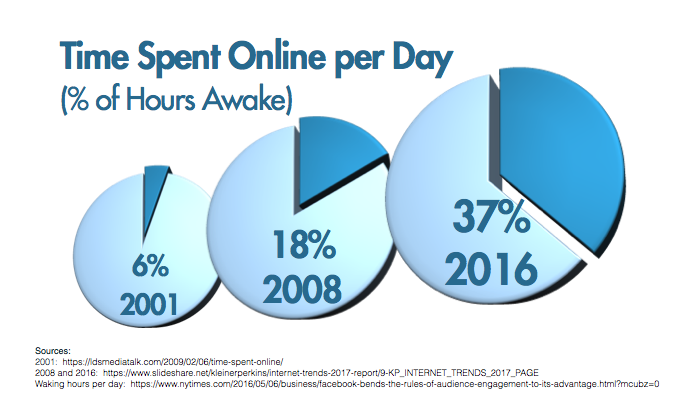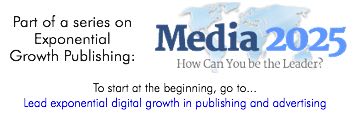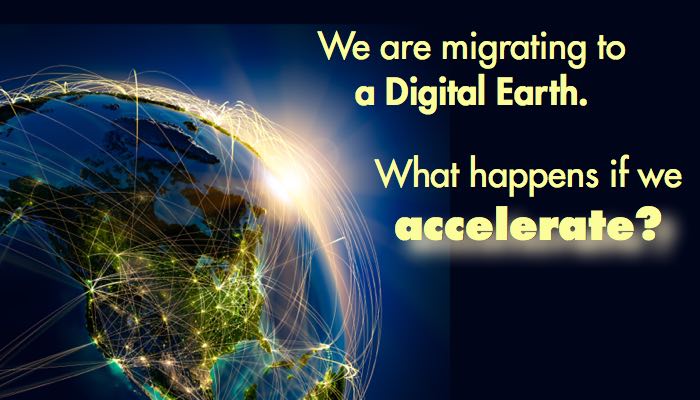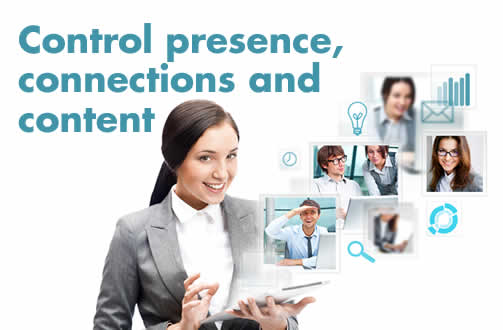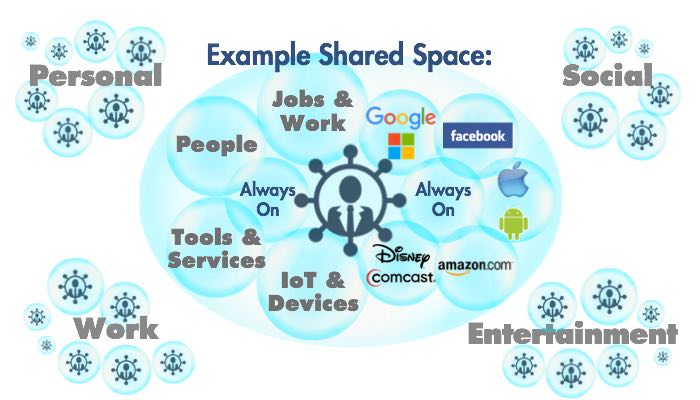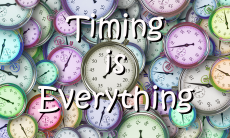Lesson for leaders
Publishing’s plight is clear: continuing today’s publishing platform is a recipe for disaster. Tomorrow is not just another day. A global digital transformation is underway. Publishing’s current digital and business models will be obsolete.
The digital advances being developed today will propel all of humanity forward together. Publishing must find a new bridge to an always-on, multi-way 21st-century publishing platform.
Shared Life Spaces is a new generation for always-on communications. If used by one or more publishers, this will drive new exponential growth publishing. Its new media paradigm adds always-on “presence” in everyone’s minute-by-minute life, work, learning, and entertainment. Shared Life Spaces give everyone new super powered reach, abilities, and impact. This new communications paradigm could be the only way for publishers to take back the lead and re-capture both advertising and content displays.
If publishing stands still, it will continue to fall behind and recede into the past. Today’s choice is increasingly obvious: either take leadership or game over.
Today’s numbers are a giant wake-up call
Publishing’s competitors are starting to change communications into a new platform that will own large parts of a digital economy. They will increasingly concentrate the world’s wealth in their hands. We have always lived in a local and small physical world that is limited to the room and place we are in.
We are now expanding our personal lives digitally. If Facebook wins, within 5 to 10 years we will all live together in one digital room. Their planetary roadmap is already visible in today’s numbers.
According to eMarketer, 1.8 billion people use messaging apps in 2017, and this will grow to 2.3 billion people by 2020. These deliver 1-to-1 and 1-to-many text, voice, and video connections that are an exponential expansion of our local physical presence. They are a precursor for exponential growth in the digital scale and impact of our personal actions, daily lives, and group achievements.
Consider Facebook’s drive to take over digital living:
- Facebook’s “daily active users” (DAU) has reached 1.3 billion people.
- Its “monthly active users” (MAU) is over 2 billion.
- Every minute 293,000 statuses are updated, and 510,000 comments are posted.
- Every day 4.75 billion pieces of content are shared.
- Facebook’s largest age group is age 25 to 34, representing 29.7% of its users. This is the bull’s-eye demographic for many companies’ marketing.
Fifty minutes per day is what the average user spends on Facebook, Facebook Messenger, and Instagram, according to The New York Times.
Now look ahead to see how Facebook has already grown its precursor to an always-on “Facebook LIVING” of the future, called Facebook Live:
- 1 in every 5 Facebook videos is a live broadcast, created by Facebook users to share daily moments between individuals and groups.
- Facebook Live videos are watched 3X longer than recorded videos.
- Facebook Live videos are commented on 10X more than recorded videos.
As large as Facebook is, this is only a part-time change. There is already a bigger transformation taking place at work, throughout businesses worldwide. Many people go to work through screens, whether they are at a desk or using a mobile device like a phone or tablet.
Surprisingly, most of the tech used is familiar, like email, chat and video phone calls:
- In frequency of use order, the most used collaboration media are email (98%), chat apps (53%), group project management (34%), and workplace social networks (29%). (Percentages are for companies with over 500 employees.)
- In frequency of use order, the largest chat apps vendors are Skype for Business (50%), Slack (14%), Google Hangouts (11%), Microsoft Teams (7%), Atlassian HipChat (2%) and Workplace by Facebook (2%). (Percentages are for current usage of collaborative chat apps by companies with over 500 employees.)
While increasingly connected, this is hardly a transformation of work or the economy.
For publishing, the impact is clear. Only 19.5% of Americans read for personal interest, according to U.S. Government statistics. The average American reads for only 17.4 minutes in an average day. Within 5 to 10 years the growth of digital living will be massive, in real-time and normal life.
Today’s digital publishing models will be increasingly out of touch, ever closer to obsolescence. What is publishing’s new bridge to the always-on, multi-way Digital Earth?
It’s morning on your Digital Earth
As you wake and move between the bedroom, bathroom, kitchen, car, and office, your experience is seamless because your digital devices recognize you and move “you” from device to device, keeping you connected and informed. The interface adapts to each device, making it feel like you use one “multi-device.”
Everything has active knowledge guidance embedded, from sleep quality as you wake up, to weather and current events while brushing your teeth, to how your breakfast is added to your connected consumption, to the right style of clothes for that day’s calendared activities, to the best way to do your job at work.
During breakfast you use your family’s “Shared Life Space” to say good morning to your daughter at college, and your parents as they start their day.
Your digital boundaries eliminate interruptions, and display the kinds of ads, content, and information that fit your choices for healthy food, products, and values.
You start working after breakfast and during your self-driving car’s ride to work. You flip between the Shared Life Spaces of your projects and teams at work. You go to work instantly with each of them because each shared space has all that team’s tools and resources open to what you do with them, for instant-use together.
Your employer has a full range of active knowledge behind every business process and task. Alerts fire when performance falls below 70%, in case an employee needs to know the optimum “next steps” for that task. For the first time, everyone in the company is above average, with next year’s performance target raised to 75%.
You give a presentation at 10 AM and turn on its audience recognition to show which people are on your team and which are observers. You include that data in the digital recording, so you know which questions your team asks, and which come from fresh viewpoints.
What’s different?
On the one hand you’ve expanded and have “continuous presences” in multiple Shared Life Spaces.
On the other hand a powerful Digital Earth is local, just for you, at your fingertips. All of it is always on and ready to do everything for you, every minute.
You gain “people-first” super powers by living on a Digital Earth:
- Your devices are an adaptable family that follows and serves you as you move from device to device, place to place, and time to time.
- Your trusted vendors focus on connected consumption’s new visible marketplace. They serve you by learning your consumption patterns, then bring you what you want, when and where you need it.
- With digital boundaries, the visibility and participation of people, vendors, advertisements, and content are under your control, depending on what you want each minute.
- Companies and industries you don’t want are made invisible by keeping them off your devices, until they make products and services you believe in. With visibility consumers control the visible marketplace by including or excluding companies from commercial presence.
- The world’s knowledge is active, triggered by each step in an activity. It is retrieved and embedded in what you do. Its “next best steps” help everyone succeed directly and rapidly.
You’re simultaneously bigger, yet still just you. Everything is ready for your use so you can immediately achieve whatever you decide. You’re in control so you live the high quality life you believe in and value. The world is at your service. It’s a people-first re-invention of living, learning, and the economy, with people and people-first companies at the top.
Just imagine what you want and do it. And you can imagine a lot.
Shared Life Spaces: how this Digital Earth becomes the most powerful way to live and work
We’re entering history’s digital inflection. With exponential growth publishing, publishers can be the first to lead digital’s next stage: digital will include everything. Everyone can enjoy people-first superpowers. Every person can have control and be served personally as they choose the high-quality life they want.
This new digital game is only about to start. Publishers can use this choice to take the lead from the giant tech platforms. This leadership decision could be critical for solving humanity’s biggest problem, which is unlimited consumption. The Earth faces unlimited exploitation as 9 billion people reach for 20th century middle-class lifestyles. With today’s economy, we may consume the planet to death.
Leading publishers could expand digital living, business, and entertainment. A Digital Earth could be sustainable, with digital ways to include everyone, live well and grow universal digital prosperity and wealth.
The technology to build that universally prosperous Digital Earth is already here and has received over 650 patent citations from subsequent patents. Most patent citations come from world-leading companies.
From its 1,400 page patent application, the U.S. Patent Office divided this world-building specification into 31 technology categories.
Publishers could turn their current decline into 21st century exponential growth publishing. They can add people-first technology and take the lead of tomorrow’s Digital Earth.
Here are some of the communication components, and their leadership options:
- Shared Life Spaces: You have as many “shared spaces” as you want. Each is an always-on digital environment that includes people, places, tools, resources, and more.
- “Managed presence:” It’s an always-on environment with “managed presences.” So you’re not overwhelmed, presences are often inactive rather than active. “Dynamic presence awareness” is determined, delivered, and displayed. You can “be” in many shared spaces so you can flip to the shared space you want, with everything on and ready for you to activate it and use all of it instantly.
- New kind of platform: “Visible hand of the marketplace.”
- Photorealistic blended screens: Looks more real with each year’s improved technology. Blends in people, places, live video-audio, tools, resources, IoT devices, etc.
- Replace advertising and content: Just as any other component can be blended in or out of a constructed interface, advertising, and/or content can be excluded and/or replaced.
- Connected consumption: Content and ads from the user’s preferred vendors replaces current paid content and ads.
- Connects across device families: Users experience a seamless Digital Earth as they move from device to device, place to place and time to time. Your devices automatically recognize you and move your shared spaces to your current devices.
- Connections: Replaces the typical “on/off” paradigm with “always on.” A powerful Digital Earth is always connected, at your fingertips and ready for instant actions everywhere: “flip” between shared spaces to go to each of them. Focus an always-on connection to make it active.
- “Reality replacements business”: Constructed and blended displays are a service. Constructs may be photorealistic or virtual. Replacements may be known or hidden.
- Meetings, groups, and events: From small groups to large events, meetings may be many types, in many places, with many types of participants and free through paid attendance. Includes ways to simplify scheduling, communicating, and finding worldwide. Visibility may be filtered, along with the visibility of data about those attending.
- Consistent-adaptable user experience across devices: A seamless user experience for a quality life on a Digital Earth, and for achieving goals rapidly. The user interface (UI) is consistent yet adaptable to different devices and users.
- Broadcasting: Blended screens and/or shared spaces may be live or recorded broadcasts. Users may record anything from a device for future broadcasts.
There are also more components. Why so many? Because they are in a single large IP (intellectual property) filing that is already in the patenting process. As a result, these components can be patented individually or in combination until 2031. By then, many of these innovations will be normal, in wide use.
How could these “patents from the future” develop? As agile, lean, or other rapid development processes determine the most successful digital communications, the appropriate parts of this specification will be filed for patents. They become protected IP when patents are granted.
Since over 650 subsequent patents have already cited this IP, this is becoming an increasingly valuable node on the “tree” of digital technology that will be used to build tomorrow’s Digital Earth.
On the other hand, this might be put in the public domain if a benefactor wanted to do that, so patents wouldn’t be an issue.
Strategic publishing: compete from the future to take back today
Today’s publishers are trying to compete with digital versions of the last century’s publishing business models. They are being made obsolete by the rise of the giant tech platforms. If one or more publishers make the paradigm shift to an exponential growth breakout, they will lead the change from today’s world into an always-on, multi-connected Digital Earth.
Their seamless user experience will empower digital life, work, learning, and entertainment—much like Amazon’s consistent user experience dominates online commerce. Shared Life Spaces will give everyone “people-first” super powers that liberate many areas of life. Its content will flow to each person based on what they do, including always-on, multi-way exponential growth publishing. Publishers can be the first movers, and start by aiming for industry leadership—then scale that to the world.
It’s easy to begin with a small, smart team that harvests low-hanging fruit like always-on connectivity. They can skip “build it yourself” by leveraging vendors and partners who add network and platform features. Together they can grow one or more advances that continuously connect them with people every minute. They can choose one or more targeted breakouts like connected consumption, active knowledge, digital boundaries, or visible markets. For example, a connected consumption ecosystem can span users’ devices, interfaces, times, and places—and attract trustworthy vendors while adding a digital boundary that deals with competitors.
These publishers will compete from tomorrow’s paradigm and propel themselves ahead of the giant platforms. When they add “people-first” tech to benefit everyone, they can start by taking back leadership of their industry.
For founding publishers, this new platform accelerates to exponential growth by selling it as a cloud service ecosystem. Other publishers and trusted vendors can buy this to rapidly add connected consumption with their customers, industries, and markets worldwide.
Right away, other publishers start sharing each digital step of living and working with their audiences. For vendors, these always-on multi-way relationships not only add consumers in connected consumption, this helps them block Amazon’s capture of their business and industry. For users, this new communications paradigm adds new super powers that liberates every person’s reach, presence, and ambitions. For everyone and the economy, this dramatically expands many moments every day with new ways to live, enjoy, and achieve.
Exponential growth publishing in Shared Life Spaces. When will you use it to take off?
(1) Disclaimer: All articles in Media 2025 are provided “as is” for general information. Only the issued patent, such as U.S. Patent 9,183,560, and patent pending application and specification, describe patented and patent pending technology.
Related articles in Media 2025:
- First article — Executive Summary: Lead exponential digital growth through publishing and advertising
- Previous article: Connected Consumption is the new Customer Experience (CX)
- Next article: Digital Boundaries as a business can serve millions and earn billions

